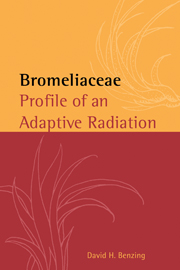Book contents
- Frontmatter
- Contents
- List of contributors
- Preface
- Acknowledgments
- Glossary
- Abbreviations
- Part one Brief overview
- Part two Basic structure, function, ecology and evolution
- Part three Special topics
- 10 Neoregelia subgenus Hylaeaicum
- 11 Cryptanthus
- 12 Tillandsioideae
- 13 Tillandsia and Racinaea
- 14 Ethnobotany of Bromeliaceae
- 15 Endangered Bromeliaceae
- Literature cited
- Name index
- Subject index
- Taxon index
11 - Cryptanthus
from Part three - Special topics
Published online by Cambridge University Press: 19 January 2010
- Frontmatter
- Contents
- List of contributors
- Preface
- Acknowledgments
- Glossary
- Abbreviations
- Part one Brief overview
- Part two Basic structure, function, ecology and evolution
- Part three Special topics
- 10 Neoregelia subgenus Hylaeaicum
- 11 Cryptanthus
- 12 Tillandsioideae
- 13 Tillandsia and Racinaea
- 14 Ethnobotany of Bromeliaceae
- 15 Endangered Bromeliaceae
- Literature cited
- Name index
- Subject index
- Taxon index
Summary
Cryptanthus (Bromelioideae) is endemic to southeastern Brazil, strictly terrestrial, and ranges from Paraíba to Rio de Janeiro states, with one species in Goiás State. Its 41 species inhabit wet forests, restingas, caatingas and campos rupestres, occurring from sea level to about 2000 m. This genus differs from all others in the family by its consistently low chromosome number (n=17) and often andromonoecious flowers with simple-erect stigmas (Fig. 3.1C).
Ramírez (1996) recently supported the case for the recognition of two subgenera proposed by Mez (1896) with geographical, morphological and ecological data. Characters that distinguish the two taxa are summarized in Table 11.1.
Members of subgenus Cryptanthus are subdivided into five sections, members of which occur in Rio de Janeiro, Espirito Santo, Minas Gerais, Bahia, Sergipe, Pernambuco, Paraíba and Goiás states (Fig. 11.1). Leaves of some of these species possess a mid-longitudinal region thickened by a succulent, many-layered hypodermis. Reproduction tends to occur primarily by stolons capable of expanding individual genets to form large colonies (Figs. 2.11C,D, 2.18C).
Members of subgenus Hoplocryptanthus occur in Espirito Santo State, except for four species native to Minas Gerais. Fruit set is more common in this group compared with subgenus Cryptanthus (evident on herbarium collections and among cultivated plants).
Ramírez (1996) tested Brown and Gilmartin's (1989a) hypothesized chromosome number evolution and related implications for phylogenetic relationships within Bromeliaceae (Chapter 9). Brown and Gilmartin proposed that the low number of chromosomes in Cryptanthus (n517 or 18) could have originated by descending aneuploidy or constitutes the ancient tetraploid condition according to the scheme illustrated in Fig. 9.10.
- Type
- Chapter
- Information
- BromeliaceaeProfile of an Adaptive Radiation, pp. 551 - 554Publisher: Cambridge University PressPrint publication year: 2000
- 2
- Cited by

